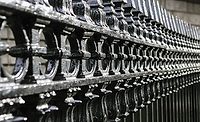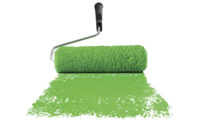Enhanced Dry-Film Coating Performance Through Controlled-Release IPBC

Upon drying, both water- and solvent-based coatings are susceptible to colonization by fungi and/or algae. The growth of microorganisms on dry film not only affects the appearance of the coating (discoloration), but it may also compromise its performance (biodeterioration). Fungi can penetrate coatings, resulting in cracking, blistering and loss of adhesion, leading to decay or corrosion of the underlying substrate. Algae colonies, which seem to grow more rapidly on porous substrates such as stucco, cement and bricks, have the ability to occlude water. The freezing and thawing of this entrapped water may induce cracking or increase the permeation properties of the coating, leading to failure. The presence of water may also encourage colonization by other microorganisms that, in turn, may cause biodeterioration.(2) The type of microorganism that can colonize the coating will depend on several factors, including moisture content of the surface, presence of nutrients, substrate and coating composition.(3)
In order to be most effective, the biocide needs to be present at the coating interface. This makes it susceptible to water leaching. Controlling the release of the biocide through encapsulation could ensure that a minimum concentration of biocide is always maintained at the surface interface, extending the shelf life of the coating. Additionally, this controlled release could reduce the amount of biocide that is released to the environment over a period of time.
This paper describes the controlled release of IPBC (3-iodo-2-propynyl butylcarbamate) through encapsulation. Long-term protection of the surface is enabled through the adsorption interaction between the biocide and the carrier.(4,5) This renders the biocide more resistant to leaching. Encapsulated IPBC was released more slowly than non-encapsulated, as measured by analytical and microbiological methods. The encapsulated biocide was also more resistant to environmental degradation from UV/heat. Furthermore, outdoor exposure tests of paints containing encapsulated IPBC showed enhanced dry-film protection.
Experimental
Paint Film Sample Preparation
Encapsulated and non-encapsulated IPBC were added at various levels to paint samples. Drawdowns were prepared by casting 3-mil films onto drawdown paperboard (Lanetta) and allowed to dry at room temperature for at least 24 h.
IPBC Measurements
IPBC Present in Leachate Water
Paint samples were prepared as described above containing 10,000 ppm of IPBC. Paint films were suspended in 100 mL water with constant stirring. The leachate water was collected at different time intervals and analyzed by GC UV-Vis spectroscopy for IPBC content. The concentration of IPBC was determined using a standard IPBC curve at maximum absorbance of 224-228 nm.
Quantification of IPBC in Paint Films by XRF
Paint samples prepared as described above containing 2,000 ppm of IPBC were leached for various time intervals at a leach rate of 1 liter per hour. Samples were dried for at least 24 h. The PANalytical Epsilon 5 X-Ray Fluorescence (XRF) instrument was used to analyze the samples for iodine content.(6) A standard IPBC curve was developed with different concentrations of IPBC and was linear up to 4,000 ppm of IPBC. The linear correlation was independent of the paint formulation used to make the film. Base lines of each paint film were obtained before and after leaching.
Delta Y Measurements
Paint samples were prepared as described above containing 1,000 ppm of IPBC. Samples were placed in the QUV unit under UVB bulbs for 24 h. The YI (yellowness index) was measured with a spectrophotomer (CM2500d from Konica Minolta) within 1 h after taking the films from the QUV unit (ASTM E 313 - 10 Standard Practice for Calculating Yellowness and Whiteness Indices from Instrumentally Measured Color Coordinates). The Delta Y was determined by subtracting the YI of the biocide-treated sample minus the untreated control sample after QUV exposure.
Efficacy Studies
Accelerated Fungal Testing
ASTM D 5590 (Determining the Resistance of Paint Films and Related Coatings to Fungal Defacement by Accelerated Four-Week Agar Plate) was used to measure efficacy of the various biocide treatments on the paint films. Samples were prepared as described above except that 500 ppm of IPBC was added to the paint samples. Paint samples were leached as described above and inoculated with a mixed fungal suspension consisting of Aspergillus niger (ATCC 6275) and Penicillium funiculosum (ATCC 11797), 107 spores/mL final concentration. The plates were then incubated for 28 days at 28 ºC and 85% RH. Fungal growth was rated on the surface of the painted sample on a scale from 0-4, where “0” represents no growth; 1 represents traces of growth (< 10%); 2 represents light growth (10-30%); 3 represents moderate growth (30-60%) and 4 represents heavy growth (60% to complete coverage).
Outdoor Test Fence Exposure
Paint samples were prepared containing 3,000 ppm of IPBC (encapsulated and non-encapsulated). Western Red Cedar was used as a substrate. Every panel was brush coated with one coat of primer on the smooth veneer side and also back coated with one coat of aluminum paint. The panel was divided into three equal 1-foot sections. The center served as a control and received two coats of the paint with no fungicide. The left and the right sides received two topcoats of biocide-treated paint. After drying, the panels were exposed facing North at a 90º angle.

|
| Figure 1 Click to enlarge |
Results and Discussion
The controlled release of IPBC from paint films was investigated in different ways. The films were placed in water and the leachate was collected at various time intervals. The amount of IPBC that leached out was measured by UV spectroscopy. Figure 1 shows the cumulative IPBC content in the leachate. Encapsulating the IPBC (IPBC CR) resulted in a decreased amount of IPBC leaching out of the film. In order to measure the amount of IPBC remaining on the surface of the coating, a non-destructive X-Ray fluorescence (XFR) methodology was developed.

|
| Figure 2 Click to enlarge |
As shown in Figure 2, the amount of IPBC remaining in the film was higher for the encapsulated IPBC. The amount of IPBC released also depended on the intrinsic properties and composition of the paint. In this example, the glossy paint showed higher retention levels of the IPBC than the flat paint.
Microbiological tests were additionally used to demonstrate the controlled release of the encapsulated IPBC. Surface protection assays were conducted according to ASTM Method D 5590. In this four-week accelerated study, the amount of fungal growth on the sample was measured after 28 days of incubation. As shown in Table 1, the encapsulated biocide (IPBC CR) provided longer-lasting protection to the surface of the sample (0 rating) after extensive leaching.

|
| Table 1 Click to enlarge |
Tests were also conducted outdoors. Wood panels containing encapsulated vs. non-encapsulated IPBC were exposed in the test fence. A quick-fail acrylic exterior paint was used in these studies. After 18 months exposure, samples were evaluated for the degree of defacement on the paint surface. As shown in Figure 3, the sample containing the encapsulated biocide showed the least surface defacement.

|
| Figure 3 Click to enlarge |
Additional experiments were conducted to demonstrate that the encapsulated IPBC shows reduced yellowing when exposed to UV light. Paint samples containing the different biocides at 1,000 ppm were exposed to UV radiation (B-bulbs, 24 h). As shown in Figure 4, the encapsulated biocide was less susceptible to yellowing after UV/heat exposure in the two different paints tested.

|
| Figure 4 Click to enlarge |
Conclusions
The controlled release of IPBC through microencapsulation into an inorganic carrier was demonstrated by analytical and microbiological assays. The controlled release mechanisms maintain a minimum biocide concentration in the coating interface over an extended period of time, preventing fungal growth. This results in a longer coating shelf life given the same initial biocide concentration. Alternatively, lower biocide levels could be used to obtain a similar shelf life. The inorganic carrier provides the molecule additional protection against environmental degradation processes (such as UV/heat degradation), further enhancing dry film protection. IPBC CR is currently available from ISP as a 40% IPBC dispersion under the trade name Fungitrol® 940CR.
This paper was presented at the 38th Annual Waterborne Symposium, February 2011, in New Orleans.
Looking for a reprint of this article?
From high-res PDFs to custom plaques, order your copy today!









